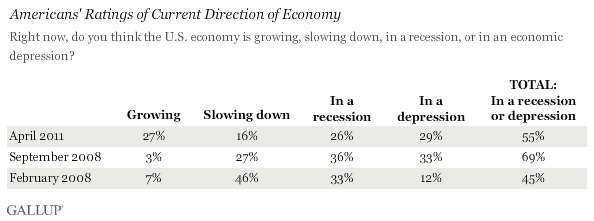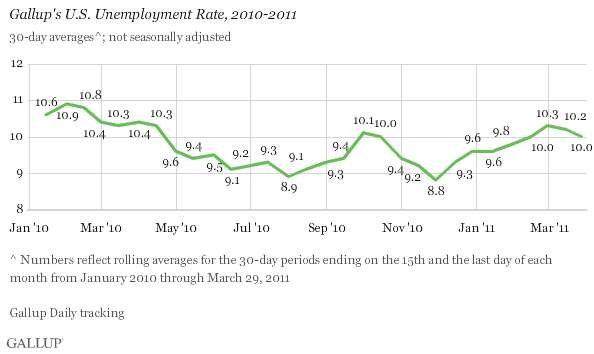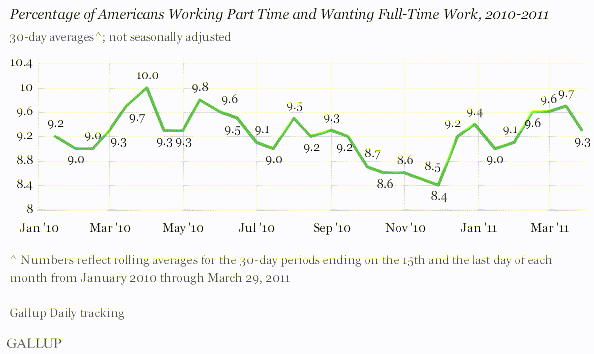-
Poll Watch: 55% Say the United States is in Recession or Depression

According to the latest Gallup Poll.More than half of Americans (55%) describe the U.S. economy as being in a recession or depression, even as the Federal Open Market Committee (FOMC) reports that “the economic recovery is proceeding at a moderate pace.” Another 16% of Americans say the economy is “slowing down,” and 27% believe it is growing.
This poll is better than September 2008 which was the height of the financial melt down, but still higher than 6 months earlier. Most Californians I speak to perceive the economy continuing in recession.
What are the implications?
Although economists announced that the recession ended in mid-2009, more than half of Americans still don’t agree. These ratings are consistent with Gallup’s mid-April findings that 47% of Americans rate the economy “poor” and 19.2% report being underemployed.
It also seems likely that most Americans would not agree with the FOMC’s assessment of the current economic recovery. Nor does it seem likely that — given surging gas and food prices — most would agree with the Committee that “longer-term inflation expectations have remained stable and measures of underlying inflation are subdued.”
Although the FOMC seems to perceive current economic conditions differently than most Americans, it does say it needs to “promote a stronger pace of economic recovery” by continuing its aggressive monetary policy, often referred to as “quantitative easing,” through June. On the other hand, in the press conference after the FOMC’s April meeting — the first ever by a Fed chairman — Ben Bernanke said that, “the trade-offs are getting less attractive at this point,” meaning it is getting harder to aggressively add liquidity to stimulate stronger economic growth while avoiding inflation.
In another possible disconnect with monetary policymakers, many Americans may not see the trade-off Bernanke suggests between promoting a stronger economy and experiencing higher inflation. Right now, prices are soaring, yet the latest Gallup Daily tracking data show that 67% of Americans say the economy is “getting worse.”
So, is the predicted inflation the answer?
Doubtful – as some Americans continue to remember the days of Jimmy Carter.
-
The Share of Americans Working Has Fallen to Lowest Level in Three Decades
 According to the latest numbers from USA Today.
According to the latest numbers from USA Today.Only 45.4% of Americans had jobs in 2010, the lowest rate since 1983 and down from a peak of 49.3% in 2000. Last year, just 66.8% of men had jobs, the lowest on record.
The bad economy, an aging population and a plateau in women working are contributing to changes that pose serious challenges for financing the nation’s social programs.
Another change: the bulk of those not working has shifted from children to adults.
In 2000, the nation had roughly the same number of children and non-working adults. Since then, the population of non-working adults has grown 27 million while the nation added just 3 million children under 18.
The numbers for California are worse – 37.3%
And, these numbers will drive the policy discussions about the economy, jobs and entitlement programs for the baby boom generation.
Other key findings:
•Men leave. Working-age men have been dropping out of the labor force for decades. The disappearance quickened when construction and manufacturing jobs vanished in the recession from December 2007 through June 2009. Until the 1960s, more than 80% of men worked.
•Women stay. The trend of women getting jobs offset the loss of working men until the late 1990s. The share of women holding jobs rose from 36% in 1960 to 57% in 1995, then leveled off. The rate was 56% in 2010.
-
Poll Watch: U.S. Unemployment Rate is 10% in March – Down From February – But So What?

America’s unemployment rate was down in March 2011 and down from March 2010 as measured by Gallup.Unemployment, as measured by Gallup without seasonal adjustment, was 10.0% in March — down from 10.2% in mid-March and 10.3% at the end of February, but above the 9.8% at the end of January. U.S. unemployment was 10.4% at the end of March a year ago.
What about the percentage of part-time workers?

And, underemployment also declined in March.

But, what does this mean? Is America’s economy improving?
Not according to Gallup.
ADP on Wednesday reported that U.S. private-sector jobs increased by 201,000 in March — the third consecutive month at this level of job growth. At the same time, Challenger, Gray & Christmas showed a sharp decline in March U.S. layoffs compared with last year. All of this is consistent with Gallup’s Job Creation Index, which has shown slightly more jobs being created and comparatively low layoffs during the first quarter of 2011.
However, contrary to the federal government’s recent job reports, Gallup’s unemployment and underemployment measures suggest that recent job increases have not been sufficient to significantly improve the jobs situation so far in 2011. Although both of Gallup’s measures were marginally better in March, they remain higher now than they were in January.
The March improvement in the jobs situation compared with February may be partly the result of seasonal hiring patterns, with companies increasing their hiring at this time of year. However, the 2010 jobs situation didn’t show substantial improvement until the second half of April. Regardless, the decline in the underemployment rate year-over-year is consistent with a cautious hiring approach in which employers avoid layoffs while taking on more part-time workers and limiting their hiring of full-time employees.
Despite the March uptick, Gallup’s view of the U.S. jobs situation remains substantially less optimistic than the government’s recent unemployment report might suggest. Added to this, late March Gallup Daily tracking results show a continuing decline in economic optimism, a pullback in consumer spending, and a drop in Gallup’s Job Creation Index. This suggests that recent behavior on Main Street does not reflect the government’s rosier assessment. It also implies that the recent marginal improvement Gallup finds may be more temporary than one might hope.
Looks like the Obama Administration is spinning the numbers to creat some economic optimism but too many Americans remain out of work and economic activity remains stagnant at best.